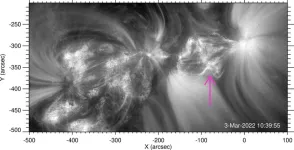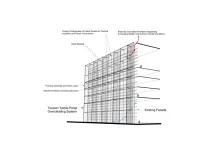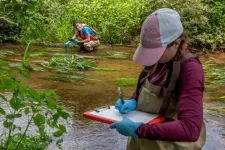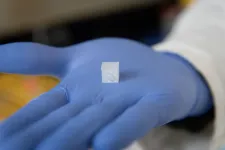(Press-News.org) SAN ANTONIO — May 15, 2023 —Southwest Research Institute (SwRI) scientists observed the first close-ups of a source of energetic particles expelled from the Sun, viewing them from just half an astronomical unit (AU), or about 46.5 million miles. The high-resolution images of the solar event were provided by ESA’s Solar Orbiter, a Sun-observing satellite launched in 2020.
“In 2022, the Solar Orbiter detected six recurrent energetic ion injections. Particles emanated along the jets, a signature of magnetic reconnection involving field lines open to interplanetary space,” said SwRI’s Dr. Radoslav Bucik, the lead author of a new study published this month in Astronomy & Astrophysics Letters. “The Solar Orbiter frequently detects this type of activity, but this period showed very unusual elemental compositions.”
In one ion injection, the intensity of the rare isotope Helium-3 exceeded the amount of hydrogen, the most abundant element on the Sun, and the levels of iron were similar to the isotope Helium-4, the second most abundant element on the Sun. In another injection two days later, the amount of Helium-3 had significantly decreased to an almost negligible amount.
“Our analysis shows that the elemental and spectral variations in recurrent injections are associated with the shape of the jet, the size of the jet source and the distribution of the underlying photospheric field that evolved over time,” Bucik said. “We believe that understanding the variability in recurrent events from a single source sheds light on the acceleration mechanism in solar flares.”
The observations made by Solar Orbiter are unique as the propagation effects that can affect abundances could be minimal near the Sun. The distance of just 0.5 AU has given the scientific team a remarkably detailed view of solar events.
“When we are closer, we have a considerably better spatial resolution,” Bucik said. “We are able to gain more insight into the source of these energetic particles because we can see the internal structure associated with acceleration processes as the injection evolves. Observations from twice that distance, 1 AU, are not very clear in comparison.”
Bucik and his colleagues hope to learn even more from the Solar Orbiter’s closest approaches to the Sun at 0.3 AU.
“These observations could help predict future solar energetic particle events,” Bucik said. “These particles can damage satellites and equipment and potentially harm astronauts. We want to understand how they accelerate away from the Sun and what the conditions are for their acceleration.”
The paper “Recurrent 3He-rich solar energetic particle injections observed by Solar Orbiter at ~0.5 au,” appears in Astronomy & Astrophysics (Letters to the Editor): https://www.aanda.org/component/article?access=doi&doi=10.1051/0004-6361/202345875
For more information, visit https://www.swri.org/heliophysics.
END
Latest research provides SwRI scientists close-up views of energetic particle jets ejected from the Sun
New study observes unusual isotope variations in solar particle injections
2023-05-15
ELSE PRESS RELEASES FROM THIS DATE:
New project to design building skins to retrofit energy-inefficient structures
2023-05-15
Older buildings tend to leak heat through their walls, requiring much more energy to maintain a comfortable temperature in summer or winter. Those constructed prior to the late 1970s rarely meet today’s more rigorous energy standards. And yet they account for large proportion of the buildings standing today. In the US, about 44% of the residential building stock was built before 1970 and about half of the commercial buildings that exist today were built before the 1980s, which creates a significant need for energy retrofitting to reduce environmental impact. A new industry-academic collaboration between Jefferson and Lightweight ...
Heat-loving marine bacteria can help detoxify asbestos
2023-05-15
Asbestos materials were once widely used in homes, buildings, automobile brakes and many other built materials due to their strength and resistance to heat and fire, as well as to their low electrical conductivity. Unfortunately, asbestos exposure through inhalation of small fiber particles has been shown to be highly carcinogenic.
Now, for the first time, researchers from the University of Pennsylvania have shown that extremophilic bacteria from high temperature marine environments can be used to reduce asbestos’ toxicity. The research is published in ...
First-in-human trial of oral drug to remove radioactive contamination begins
2023-05-15
WHAT:
A first-in-human clinical trial of an experimental oral drug for removing radioactive contaminants from inside the body has begun. The trial is testing the safety, tolerability and processing in the body of escalating doses of the investigational drug product HOPO 14-1 in healthy adults. The National Institute of Allergy and Infectious Diseases (NIAID), part of the National Institutes of Health, is funding the Phase 1 trial, which is sponsored and conducted by SRI International of Menlo Park, California.
Internal radioactive contamination occurs when radioactive ...
Crushed clams, roaming rays: acoustic tags reveal predator interactions
2023-05-15
Clam leases are designated underwater locations used to produce hard clams of all sizes from littlenecks to chowders. Clam production or aquaculture can be a risky business due in part to unwanted marine intruders. Among them, stealthy and highly mobile rays.
The Indian River Lagoon is one key location used for hard clam (Mercenaria mercenaria) aquaculture operations along Florida’s Atlantic coast. Clam fishermen have anecdotally reported seeing rays in clam leases and suspect that their interactions could result in damaged aquaculture gear and crushed clams. After all, ...
EPA's new PFAS rules don’t account for major source of drinking water contamination
2023-05-15
CAPE COD, MASSACHUSETTS – Earlier this year, the US Environmental Protection Agency proposed maximum allowable levels in drinking water for six PFAS (per- and polyfluoroalkyl substances) – so-called forever chemicals. But the draft standards do not account for half of the PFAS at contaminated sites across the country.
The findings are from a team led by the Harvard John A. Paulson School of Engineering and Applied Sciences (SEAS) and are published in the journal Environmental Science & Technology.
PFAS are present in fire retardant foams ...
Communities of color disproportionately exposed to PFAS pollution in drinking water
2023-05-15
Embargoed for release: Monday, May 15, 2023, 8:00 AM ET
Boston, MA – People who live in communities with higher proportions of Black and Hispanic/Latino residents are more likely to be exposed to harmful levels of per- and polyfluoroalkyl substances (PFAS) in their water supplies than people living in other communities, according to a new study led by researchers from Harvard T.H. Chan School of Public Health. The researchers link this finding to the disproportionate siting of sources of PFAS pollution—such ...
WFIRM bioprinting research makes history when it soars to the ISS
2023-05-15
WINSTON-SALEM, NC – MAY 15, 2023 – The Wake Forest Institute for Regenerative Medicine (WFIRM) will make history this month when the first bioprinted solid tissue constructs soar to the International Space Station (ISS) on board the next all private astronaut mission by commercial space leader Axiom Space.
The Axiom Mission 2 (Ax-2) launch by Houston-based Axiom Space is launching from Florida’s Kennedy Space Center. The crew will conduct extensive scientific research experiments including WFIRM’s vascularized tissue research – which won first place in the NASA Vascular Tissue Challenge in 2021.
Liver ...
Smartphone use goes up in city parks, but down in forests
2023-05-15
While a visit to the great outdoors is a common prescription for reducing screen use, a pioneering new study finds that time outdoors doesn’t always reduce smartphone screentime.
The new research, which tracked smartphone activity of 700 study participants for two years, reveals that participants’ smartphone activity actually increased during visits to city parks and other urban green spaces.
With smartphone use rising worldwide, the study clearly identifies a powerful way to reduce screen time: participants who visited nature reserves or forests saw significant declines in screentime over the first three hours, ...
New study finds the placenta, not only the brain, plays a central role in genetic risk of schizophrenia
2023-05-15
BALTIMORE, Md. (May 15, 2023) – More than 100 genes linked to the risk of schizophrenia seem to cause illness because of their role in the placenta rather than in the developing brain, according to a new study led by the Lieber Institute for Brain Development.
Scientists had generally assumed for over a century that genes for schizophrenia risk were principally, if not exclusively, about the brain. But the latest research, just published in Nature Communications, found that the placenta plays a much more significant role in developing illness than previously known.
“The secret of the genetics of schizophrenia has been hiding in plain ...
Wide-ranging strategies needed to eliminate racial and ethnic inequities in stroke care
2023-05-15
Statement Highlights:
In a review of the latest research, few stroke studies addressed racist policies, such as residential segregation, or social determinants of health, such as neighborhood deprivation, walkability or security; food availability; economic stability; education quality; or employment and health insurance, all of which play a role in stroke incidence, care and outcomes.
The statement summarizes research on interventions to address racial and ethnic disparities in stroke care and outcomes.
Additional research is needed to determine ...
LAST 30 PRESS RELEASES:
Flaring black hole whips up ultra-fast winds
Study explores the link between newspaper preference and attitudes towards autism
Artificial turf in the Nordic climate – a question of sustainability
The hidden toll of substance use disorder: annual cost of lost productivity to US economy nearly $93 billion
Among psychologists, AI use is up, but so are concerns
Recycling a pollutant to make ammonia production greener
Common institutional ownership linked to less aggressive business strategies in Chinese firms
Energy and regional factors drive carbon price volatility in China’s emissions trading markets
Researchers from NUS Medicine and the Institute of Mental Health detect early brain changes linked to future psychosis development
Cryopreserved vs liquid-stored platelets for the treatment of surgical bleeding
Cost-effectiveness of cryopreserved vs liquid-stored platelets for managing surgical bleeding
Adaptive Kalman filter boosts BDS-3 navigation accuracy in challenging environments
Home-based monitoring could transform care for patients receiving T-cell redirecting therapies
Listening to the 'whispers' of electrons and crystals: A quantum discovery
Report on academic exchange (colloquium) with Mapua University
Sport in middle childhood can breed respect for authority in adolescence
From novel therapies to first-in-human trials, City of Hope advances blood cancer care at the American Society of Hematology (ASH) annual conference
Research aims to strengthen the security of in-person voting machines
New study exposes hidden Alzheimer’s 'hot spots' in rural Maryland and what they reveal about America’s growing healthcare divide
ASH 2025: Study connects Agent Orange exposure to earlier and more severe cases of myelodysplastic syndrome
ASH 2025: New data highlights promise of pivekimab sunirine in two aggressive blood cancers
IADR elects George Belibasakis as vice-president
Expanding the search for quantum-ready 2D materials
White paper on leadership opportunities for AI to increase employee value released by University of Phoenix College of Doctoral Studies
ASH 2025: New combination approach aims to make CAR T more durable in lymphoma
‘Ready-made’ T-cell gene therapy tackles ‘incurable’ T-cell leukemia
How brain activity changes throughout the day
Australian scientists reveal new genetic risk for severe macular degeneration
GLP-1 receptor agonists likely have little or no effect on obesity-related cancer risk
Precision immunotherapy to improve sepsis outcomes
[Press-News.org] Latest research provides SwRI scientists close-up views of energetic particle jets ejected from the SunNew study observes unusual isotope variations in solar particle injections





